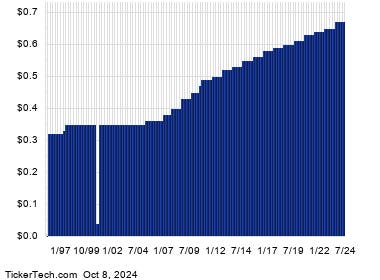On October 10, 2024, Verizon Communications, Oracle, and AT&T are set to trade ex-dividend, marking an important date for investors looking to gain dividends from these prominent companies. Verizon is prepared to distribute a quarterly dividend of $0.6775 on November 1, 2024, while Oracle will issue a $0.40 dividend on October 24, 2024. AT&T will also pay its quarterly dividend of $0.2775 on November 1, 2024. The ex-dividend date is crucial as it determines which shareholders are entitled to the upcoming distributions, making it significant for those managing investment portfolios focused on income generation.
Calculating the impact of the ex-dividend dates on stock prices provides insight into investor behavior in response to dividend announcements. For Verizon Communications, with a recent stock price of $43.84, the dividend translates to an approximate yield of 1.55%, suggesting that shares of VZ are likely to trade lower by the same percentage when markets open on October 10. Similarly, Oracle is expected to decrease by 0.24%, while AT&T shares may witness a drop of 1.27%. These adjustments in share prices reflect the initial perception of dividends and how investors incorporate the upcoming cash payments into their valuation strategies.
Historical dividend data is an essential tool for investors to gauge the reliability of a company’s dividend payments over time. Assessing the dividend history of Verizon, Oracle, and AT&T can offer insights into the stability and sustainability of their recent declarations. Companies often face fluctuations in profits that can lead to changes in dividend policies. Thus, a thorough examination of previous dividends can provide investors with a clearer picture of what they might expect for annual yields in the future.
Looking toward the future, current estimates suggest a promising annualized yield for each company, should they maintain their dividends. Verizon Communications is projected to sustain an annual yield of 6.18%, enticing for income-focused investors. Oracle, on the other hand, has a lower anticipated yield of 0.94%, reflecting its position in the tech sector where reinvestment into growth may take precedence over high dividend payouts. Meanwhile, AT&T presents a solid 5.10% estimated yield, attracting a stable pool of investors seeking reliable income streams.
Market performance provides additional context for these companies as investors react to changing stock valuations. As of recent trading days leading up to the ex-dividend date, Verizon’s shares have experienced a decrease of approximately 0.8%, Oracle’s have fallen by 0.5%, and AT&T’s shares are down by around 0.6%. The slight declines in stock prices might be indicative of investor behavior as they adjust their holdings in response to the upcoming dividend distributions and overall market sentiment.
In summary, the ex-dividend dates for Verizon, Oracle, and AT&T are pivotal for investors tracking dividend yields and company performance. The anticipated dividend distributions, along with historical data and current market reactions, contribute to a comprehensive understanding of these companies’ financial health and investment viability. As dividend announcements influence stock prices and investor sentiment, maintaining awareness of these factors can significantly aid investment decisions in the future.

